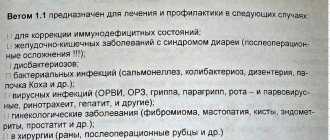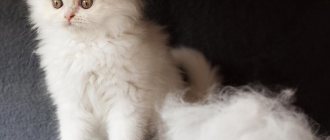A cat shows its mood through body language
To the average person, felines seem illogical and incomprehensible creatures. Here the cat is caressing. And after five minutes it’s already hissing and ready to bite off your leg. What with her? Maybe she's sick? Or did the person offend her?
In the article, we looked at what cat body language is and how pets express their mood through movements and poses. You will also learn how to learn to understand cat body language.
Cat sign language: poses and movements
When a person lives with cats, it would be good to learn to understand what they want and what they are thinking about. Cat language is not something extremely complex. Watch your pet and you will understand the difficulties of translation.
Tail as a mood indicator
The tail is a mood indicator
The easiest way to learn to understand the language of your favorite cat is by its tail, which immediately shows the animal’s mood.
The straight, extended upward, sometimes slightly twitching tail of a kitty that meets its owner at the threshold of the apartment indicates that the pet is in an excellent mood. She caresses, meows quietly and briefly, showing her owner that she misses him.
If the cat swings its tail in different directions, hisses and looks at the owner with wide open eyes, leave the pet alone. He is angry and wants to be alone.
The readiness to attack in cats is expressed in body language by a fluffy, straight tail.
If the cat doesn't really want to communicate, he will lower his tail and wag it slightly from side to side.
A tucked tail means that the pet may have misbehaved or is afraid. The owner should carefully inspect the house: suddenly the pet had a lot of fun while he was home alone and now he is ashamed. If there are no signs of damage, try to find out what scared the cat.
Dog and cat tongues
As for dogs, they perceive people differently than cats. Researchers from the University of Hungary have found that dogs actually understand what people say. True, in the language the owner speaks.
An experiment was conducted in which the brain activity of thirteen dogs was recorded using special equipment. For seven minutes, they listened to their coaches' voices through headphones as they taught them the command to "down."
Brain imaging has shown that dogs process voices the same way humans do, using the left side of the brain. Using the right side, they recognize the tone and pitch of a person's voice.
Dogs also understand words and how they are said. Meaningful words spoken in a neutral tone did not have the same effect as words spoken in an encouraging tone.
Attila Andics, the lead curator of this study, believes that dog brains process what and how exactly we say. This is due to the fact that dogs have lived with people for a long time and have learned to adapt to them.
What about different languages and how animals understand them? Will a Japanese Akita from Tokyo understand the bark of a German Shepherd from Munich?
Scientists believe that for animals there are no linguistic differences between the languages of humans. A dog will always understand another dog, no matter where it comes from.
However, people from different countries perceive a dog's bark differently, depending on where a particular person was born and where he actually grew up.
Linguists call this phenomenon “onomatopoeia” - the process of onomatopoeia, when we try to characterize the real source of a sound with a word that sounds similar. For example, “meow”, “rumble”, “croak” and so on. Moreover, such vocabulary depends on the country and the specific language.
So, “woof-woof” is far from a universal option. There are also “wouaff-wouaff” and “ouah-ouah” in French, “wuff-wuff” or “vow-vow” in German, “guau-guau” or “gua-gua” in Spanish.
The only thing that can be said with absolute certainty is that everywhere dogs bark twice. For example, an Israeli dog will say “hav-hav”, and a Japanese dog will say “wan-wan”.
Likewise, “meow” is one of many variations of a cat’s phrase. Italian is “miao”, French is “miaou”, English is “meow”, Danish is “miav” and so on.
Dictionary of cat gestures
Even if furry household members do not speak humanly, the body language of cats is sometimes more eloquent than words.
Cats talk to humans using long, short, loud, and quiet “meows” and “mrr.” To fully understand the language of cats, which contains about 30 gestures, the owner will have to be patient.
Friction on legs
Cats rub their legs to mark their territory. Yes, the owner is part of it and must carry the scent of a home friend. Perhaps the owner communicated with another tailed animal on the street or at a party. The cat will immediately find out about this and may be dissatisfied.
Head butting or poking with a wet nose is a sign of friendliness and love.
Mustache
With the help of their whiskers, cats explore the world around them. They don't even have to touch the object of interest. Try bringing a treat to your pet's face. The whiskers will rush to the hand, and the cat will instantly know everything about the delicacy.
Vibrissae are as important to cats as hands are to humans.
Eyes
If the pet looks straight into the eyes and then closes them, it means that she is happy with everything.
A dilated pupil indicates that the cat may be scared or confused.
You can recognize a frightened cat by its eyes.
Ears
When a cat is in a good mood, her ears will be on top of her head. But if the pet turned them to the sides and pressed them to the head, it means something angered her.
Readiness for a fight with a person or another feline is shown by ears tightly pressed to the head.
Body
An offended cat will defiantly sit away from its owner. She can hide her muzzle in her paws, showing that she should not be disturbed now. The owner may have been unfairly offended and should think about his behavior.
Often, a cat, sitting and purring on the owner’s lap or chest, begins to shift from paw to paw. This is how they demonstrate complete trust. As a kitten and sucking milk, he also kneaded his mother's belly.
If your pet puts out its claws during a “massage” session, do not immediately hit it and throw it on the floor. Carefully reposition the cat and pet it. After all, she didn’t hurt on purpose.
An application has been developed that understands the speech of cats
Cat owners will now be able to understand their pets. According to Geek Wire, the MeowTalk application was created based on machine learning. The robot studies the sounds made by the cat and, using the collected database, offers a translation into human language. Thus, the program classified sounds according to 10 implemented parameters.
The collected collections of sounds made it possible to identify the main vocal wishes of the cat - from a request to eat to a request to play or, conversely, not to pester. The developers were based on completely scientific works, such as a study by Stavros Ntalampiras called “automatic classification of cat vocalizations emitted in different contexts.”
One of the authors of the idea, Javier Sanchez, has been working on the project for about six months. He is sure that during a pandemic, cats and their owners, willy-nilly, become the closest friends in forced seclusion, and therefore they need to understand each other better. In his opinion, cats do not have a common language, so the application is trained to understand a specific animal and works for it.
The program can already be downloaded on Android and iOS smartphones. Using user input, you can create cat profiles and make your own tags in MeowTalk if you're sure you understand the cat. The app will learn a new word and make a translation the next time it hears it from the cat's mouth. The more “words” and scenarios are collected in the application, the more interesting it becomes.
There the user will find additional technical features that are currently under development. For example, a smart collar that will hear meowing and reproduce in a human voice what the cat said. The application on the phone will also help to inform the owner of a cat that has gone on a spree that he has returned and is waiting behind a closed door.
Interestingly, dogs can understand human language, but they don't speak it. But cats are not at all interested in what the owner says, and they speak their own language.
Rostov breeder of Maine Coon cats Elena Melikhova told RG that Maine Coons are very talkative, they are the most intelligent breed. When asked if she would like to have an application on her phone that would help communicate with the cat - translate its meow - Elena replied: “I don’t. Because I understand my pets without a translator. I can easily determine how a cat calls kittens, or asks for food, or simply attracts attention. Well, the way a cat calls a cat cannot be confused with anything!”
The expert added that for those who are just starting to get acquainted with cats and are planning to get a pet, perhaps such a translator will help them quickly find a common language with them.
A cat's tongue can be understood by the movements of the animal's tail.
Experts believe that it is the tail that is most clearly able to indicate in what state the mustachioed pet is currently in. This part of a cat's body is an indicator of his mood, and the tail can tell a lot.
The cat demonstrates its irritation or interest by waving its tail to the sides. If this is associated with irritation, then the condition may worsen, and then the cat will not just wag its tail, but will begin to show its displeasure more aggressively.
Quite strong blows of the tail up and down mean that the cat is very worried or worried about something. At the same time, the tail becomes much fluffier than always, because all the hairs on it stand on end. This is a manifestation of strong anger and a willingness to attack. In such a situation, you should not touch the cat.
If an animal is depressed or afraid of something, this will be clear by the tail tucked between its legs. Until the source of danger is eliminated, the cat will not calm down.
The cat’s tail stands in a “pipe”, and its tip is slightly curved to the side - the animal is happy. If the tail sadly trails behind the cat, he is tired or disappointed in something.
A trembling tail means a certain “activity” of the cat - it marks the territory of its “domains”.
Cat tail signs:
Rules for communicating with a cat
There's no point in hiding the fact that most owners talk to their cats as if they were a child. How many owners have wondered whether their cat understands?
Judging by the research above, the cat can hear what you say perfectly well, but in most cases will ignore the semantic meaning of the words.
By nature, four-legged animals are not inclined to listen and listen to human speech, but a pet can be trained to be attentive. One of the experiments of zoologists revealed that cats do not understand the word “no”. If you often repeat the word “no” during punishment, the cat will become confused and not understand what you want from it.
When talking to a cat, it is important to always behave openly. If you need to get acquainted with an unfamiliar animal, it is best to squat down and extend your open palm towards the cat
The hand should be turned palm up, since a palm lowered to the ground can be perceived as a warning gesture.
A study conducted with a control group of 40 cats showed that the four-legged cats are well versed in human gestures. According to the results of the experiment, the most expressive gesture for a cat was considered to be the index finger raised up or extended towards the muzzle.
When establishing verbal contact with a pet, it is important to understand that the character and temperament of animals is very individual. Among cats, it is rare to find truly friendly and responsive animals that are interested in communicating with the owner.
Most calm cats have a natural shyness, which has nothing to do with sociability. If your cat constantly ignores you, try addressing her by kneeling down. Many animals ignore sounds coming from above.
If an unfamiliar cat tries to look into your eyes, try to quickly break eye contact and distract the animal.
If you are meeting a cat for the first time, it is better to show restraint and give her the opportunity to take the initiative:
- Get down to the animal's level, extend your open palm forward and wait for the cat to approach you.
- If the four-legged animal is interested in your personality, comes up, sniffs your palm and fingers, then it means it is ready to communicate.
- If the cat walked by, completely ignoring the fact of your presence, do not be upset - this is instinctive behavior.











